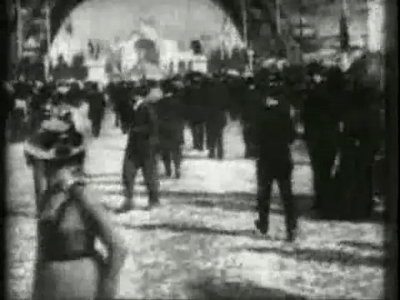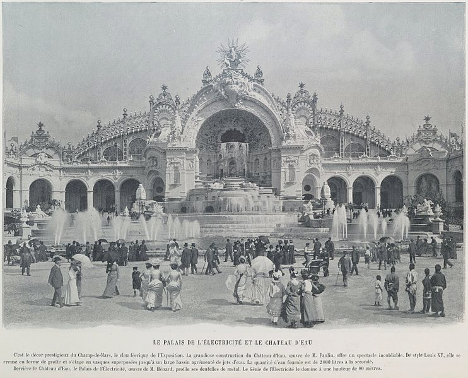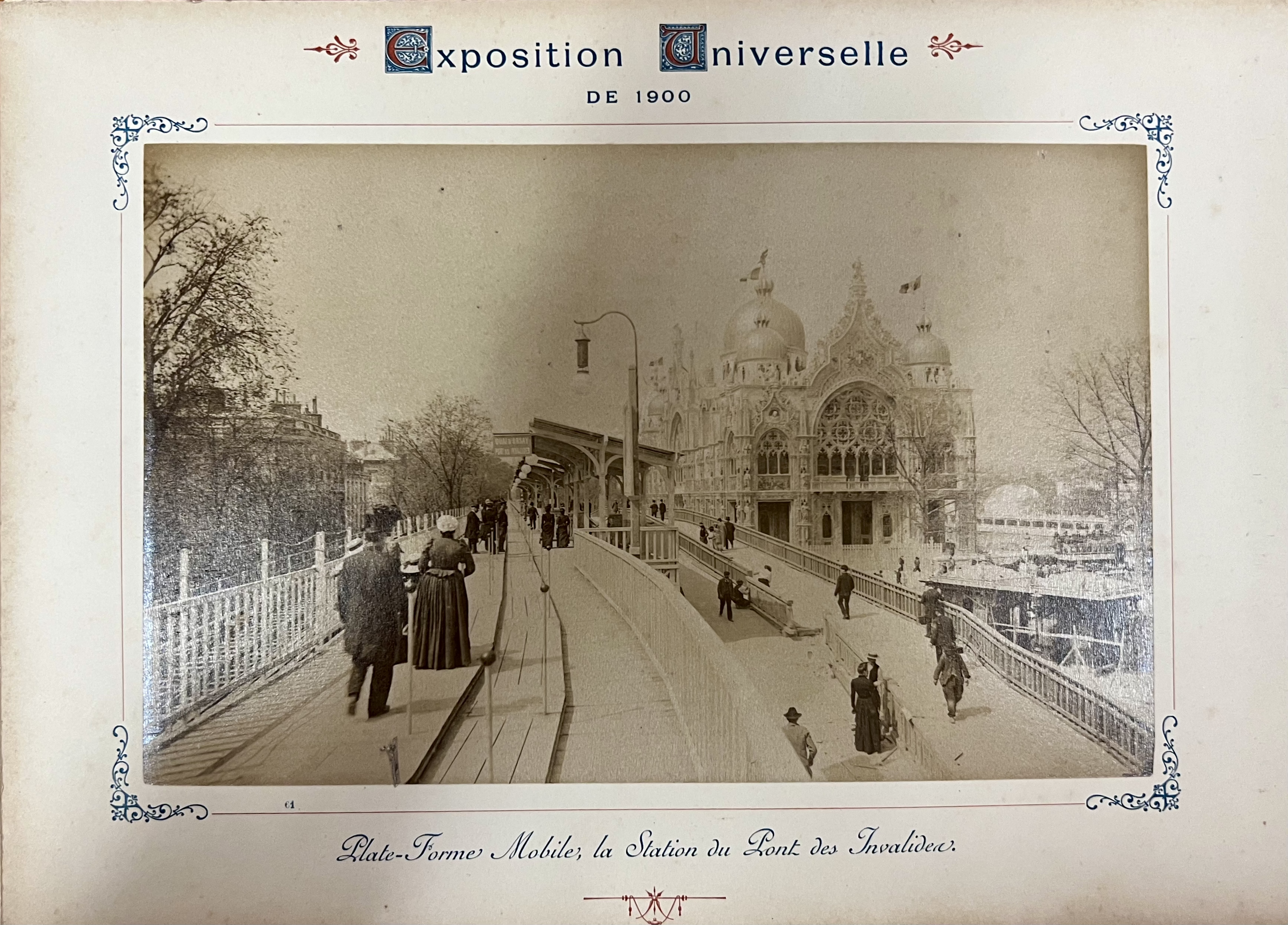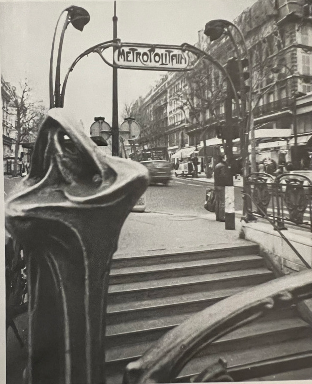1900
Colonialism on DisplayAs the event that heralded in the new century, the exposition centered around innovation. While Gallé presented his advances in woodworking and modern design, exposition officials put new technology on display and put it to use at the Palais de l’Electricité (Figure 17), Château d’Eau (Figure 17), the moving walkways that connected different pavilions (Figure 18), and the unveiling of the Métropolitain (Figure 19). Alongside these demonstrations of ingenuity, the exposition featured displays on forestry, agriculture, arboriculture, and mining, placing the finished products in the context of their production. As an international affair, the 1900 Exposition Universelle offered a platform for display to countries around the world. Decorative arts displays showing works by foreign powers, including Germany, Belgium, Italy, and Japan were situated nearby France’s Decorative Arts Pavilion, also along Esplanade des Invalides.[4] These countries similarly had displays at the mechanical and chemical pavilions, enabling them to show off their achievements and advertising their participation in modernity.

Figure 15: Gif created from “Paris in 1900 – Exposition Universelle [Rare Footage],” https://www.youtube.com/watch?v=n-4R72jTb74.
Figure 16: Agence de géographie universelle, Exposition Universele de 1900, 1900. Bibliothèque National de France.
Like Gallé’s own goals in his work, the 1900 Exposition Universelle brought art and industry together more closely than perhaps any previous exposition, with its emphasis on Art Nouveau architectural design throughout. Roger Marx was pivotal to the presence of Art Nouveau at the 1900 Exposition, and with his help, the 1900 Exposition Universelle presented the largest array of Art Nouveau artists to ever show in one place, including works by Gallé alongside contemporaries like Hector Guimard, Jacques Marjorelle, Georges Charpentier, Siegfried Bing, and René Lalique among others. As a distinctly modern style, based in nature and not on any pre-existing model, Art Nouveau was yet another exemplar of modernism at the exposition. The influence of Art Nouveau could be seen beyond the artist’s displays.[5] Art Nouveau’s stylization of nature is evident on the façade of Pavillon Bleu (Figure 20), a restaurant built for the 1900 Exposition. The abstracted floral motifs and the tangling vine-like parapet recall the same forms that Gallé was creating in his furniture. Similarly, Hector Guimard’s station entrances for the Métropolitain show Art Nouveau’s iconic whiplash curves (Figure 19). Art Nouveau’s prevalence at the 1900 Exposition further underscored a proliferation of modernity.
The 1900 Exposition Universelle exemplified the Third Republic’s policy of colonial expansion and represented France’s civilizing mission and the integration of these colonies into greater France as a part of the modern age. The French government collaborated with other entities to create reproductions of sites of French colonial activity and sell to its audiences the importance of continued imperial expansion. For most visitors, this was their only chance to confront these “exotic” cultures, and so the impressions they made were lasting ones. The Catalogue Général Officiel of the exposition remarked on these displays and their visitors, “If they cannot go to the Orient, the Orient has come to them.”[6] Visitors to the exposition could even buy souvenirs in honor of their visits to these colonialist displays. For example, Jules Charles-Roux’s drawing of the Indochinese display (1900, Figure 21) shows the display nestled in an imagined tropical landscape, populated with renderings of indigenous people. The drawing is accompanied by a caption crediting the French architect of the display, M.A. Marcel. The image is number sixty-six in his souvenir book, one among many in a series pseudo-ethnographic collectibles. In addition to shaping French perceptions of the colonies and protectorates, the exposition helped to form a sense of French national identity that defined itself around its contrast to the exoticized “other” it illustrated in these colonialist displays.
As Herman Lebovics explained, modernism and colonialism are “reciprocally potentializing,” or mutually contributing to and reinforcing each other’s development.[7] Thus, as a microcosm of the modern world, one must acknowledge the presence of colonialism at the 1900 Exposition alongside all the displays of modernity. Despite France’s policy of integration, sites of French colonialism were not treated equally, and their displays were more in keeping with a justification for France’s civilizing mission as a means of integration rather than as individual cultures with their own achievements. French colonies and protectorates, including Algeria, Cambodia, and French West Africa, whose displays included decorative arts and were admired by visitors all the same, were relegated to the furthest possible distance, diagonally across the Seine near the Palais du Trocadero.[8]
As sites of French colonialism, their utility was advertised in the form of the raw materials they could provide. Catalogues that accompanied the exposition had lists of organizations, organized by colony, with references to materials that were exported to France (Figure 22).[9] In the 1900 Catalogue Général Officiel, exposition officials wrote that advances in maritime navigation and improvements to inland waterways helped to improve ease of access to imported materials that had to travel great distances. As a result, importations of exotic woods from sites of French colonization, like Cameroon and Madagascar increased.[10] The colonial wood trade is one of the undeniable spoils of France’s colonial efforts and made the value of French colonies to France clear, providing continued economic justification for French colonialism. Despite being admired for their aesthetic value, these territories were geographically othered, and placed opposite French mechanical and industrial displays, implying that these colonies and protectorates were another on the list of French achievements. Colonial displays advertised bois des îles as one of the advantages of French colonialism. Furniture, like the works produced by Émile Gallé, showed their stunning application to the arts.
Changes in access to materials and technology created pressure for ébenistes, or cabinetmakers, to differentiate their work from furniture that was mass-produced to meet growing demands. In the 1900 Catalogue Général Officiel, exposition officials noted an increase in demand for and consumption of wood in France. They explained this was the result of the introduction of electrical machine tools that allowed for furniture to be made more quickly and less expensively. This mechanization of furniture quickly led to the mass production bon marché furniture that was more easily accessible to a growing middle class. This occurrence was coined “the era of inexpensive furniture.”[11] However, this also created a bifurcation in the market where ébenistes needed to define themselves in opposition to the industrial furniture makers. While early French woodworkers most commonly used luxury wood grown in France as it was more easily obtainable, these advances in colonial trade allowed woodworkers to become more familiar with exotic colonial woods and they used them more often.[12] As the 1900 Exposition Universelle Catalogue notes, fin-de-siècle woodworkers used bois des îles as a way to differentiate themselves and their products from bon marché furniture, through “real discoveries of taste.”[13] Luxury furniture, and thus its maker, in 1900 came to be defined by its carved ornamentation that could only be created by hand, with a gouge, and not by electrical machine tools, and by using imported and unusual materials that were more difficult to access and more expensive than the local wood that had previously been used.[14]
By the 1900 Exposition Universelle, Gallé was aligning himself with the qualities associated with fine art, and presenting them to a vast public: using rare, exotic materials, using techniques that required skilled work by hand rather than with machine, and aligning himself with the civilizing mission of France, taking raw materials imported from sites of colonialism and shaping them into refined artistic works.
[1]. The Exhibition extended from Jardins du Trocadéro, East to the Petit Palais, across the Seine to Esplanade des Invalides, and West to the Champ de Mars, exhibitions stretched between these landmarks, along both banks of the river (for a map of the Exposition grounds, see Figure 16); Mattie, World’s Fairs, 103.
[2]. Roger Benjamin, “Colonial Panoramania,” in Orientalist Aesthetics: Art, Colonialism, and French North Africa, 1880-1930, ed. Roger Benjamin (Berkeley: University of California Press, 2003), 106.
[3]. Benjamin, “Colonial Panoramania,” 106.
[4]. For reference on location, see squares 31, 32, 41, and 42 on the map grid in Figure 16.
[5]. Paul Greenhalgh, Ephemeral Vistas: The Expositions Universelles, Great Exhibitions, and World’s Fairs, 1851-1939 (Manchester: Manchester University Press, 1988), 161.
[6]. Catalogue Général Officiel / Exposition Internationale Universelle de 1900, Tome X, 108.
[7]. Herman Lebovics, “Modernism, Colonialism, and Cultural Hybridity,” in Colonial Culture in France Since the Revolution, ed. by Pascal Blanchard, Sandrine Lemaire, Nicolas Bancel, and Dominic Thomas (Bloomington, Indiana: Indiana University Press, 2013) 388-98.
[8]. For reference on location, see squares 86, 87, 96, 97, 106, and 107 on the map grid. For a full list of all French colonies and protectorates at the 1900 Exposition Universelle, see Figure 16.
[9]. Catalogue Général Officiel, Tome X, 13.
[10]. Catalogue Géneral Officiel, Tome X, 56-78.
[11]. Catalogue Géneral Officiel/ Exposition Internationale Universelle de 1900, Tome XIV, 144.
[12]. Sextro, “Materials of Empire,” 2.
[13]. Catalogue Géneral Officiel, XIV, 144.
[14]. Catalogue Géneral Officiel, Tome XIV, 144.






